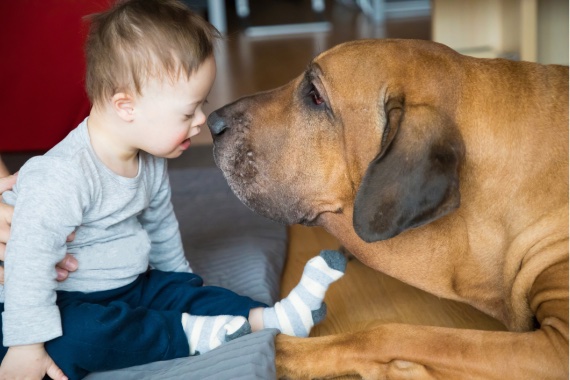If you’re reading this article with your pet dog by your side, you will undoubtedly feel a pang of connection to a pair of proto-Germans from 14 millennia ago, even if little or nothing in your modern life resembles their lived experience. Except for the dog.
There was a grave in Bonn-Oberkassel in western Germany where the remains of two humans, a man and a woman, and two dogs lay together for 14,000 years. This could be the earliest evidence of an emotional connection between species, as the burial suggests a shared familial bond between the interred individuals, and also because the younger of the two dogs, which was only a puppy, appears to have survived a serious illness, likely thanks to the care it received from its bipedal companions.

Despite the passage of so much time, one thing remains certain: the person who cared for that animal was also caring for themselves. In other words, this mutual affective bond between humans and animals has therapeutic effects that help us to maintain our emotional equilibrium, especially in the face of 21st century challenges such as the pandemic. Indeed, scientific research has demonstrated the positive impact of this bond on human well-being.
However, the research on this subject is not exhaustive. To clarify what conclusions the scientific consensus supports, we consulted Nuria Máximo, coordinator of the Animals and Society Research Chair at the Rey Juan Carlos University, and Paula Calvo, researcher, ethologist and expert in anthrozoology—the study of human-animal relationships.
To begin with, they quote a paragraph from Helen Ballantyne on the empathy already suggested at the German burial site: “Animals are our family, that’s why the bond is so deep. Some of my medical colleagues, less familiar with these powerful emotions, are surprised to realise that their patients can put the health and welfare of their animal before their own.”
Varying effects across species and therapies
What benefits have been proven beyond doubt? Mainly that the affectionate companionship of an animal can reduce levels of depression, alleviate feelings of deep loneliness, anxiety and restlessness, while improving social relationships and social skills, according to this 2018 study.

Some lines of research, such as those conducted by the NIH (National Institutes of Health) in the USA, focus not only on demonstrating how stress-related hormones are reduced and pleasurable endorphins increased, but also on narrowly defined groups. For example, terminally ill patients, people with varying degrees of autism or bipolar disorder, children diagnosed with attention deficit hyperactivity disorder, or even the possible preventive effect of early companionship with dogs and cats on the exacerbation of mental illnesses, including schizophrenia.
The results are quite mixed, both in terms of therapies and species, in the sense that for some of these pathologies the benefits seem to be greater when dogs are used. Some experiments are very curious, such as the one carried out with hyperactive children who read stories to real dogs—specially trained for this type of relationship—and to puppets imitating the same dogs, in order to check the differences in the children’s communication or social interaction.
Another study confirms some of the benefits of a child having a pet, including: “reinforcement of the child´s personality and promoting self-esteem, and in cognitive development.” However, this paper reminds us that a relationship with a pet is not a panacea; it needs to be planned to avoid accidents or mistreatment, and the company of dogs or cats is recommended rather than non-traditional or exotic species. “Having an animal helps children learn about responsibility and caring for others,” the study notes.
A two-way benefit
Among the lessons endorsed by the scientific community is that bonding is a two-way process, benefiting both two-legged and four-legged animals. To realise its full potential, it must prioritise quality and be based on shared activities—as is the case with human-to-human relationships themselves. “By being able to respond affectionately to human attentions and to elicit pro-social behaviours and positive affect, animals, especially dogs, may possess a unique capacity to serve as an emotional bridge to mediate interactions in otherwise awkward and uncomfortable therapeutic contexts,” says this analysis.

However, this research must be seen as an ongoing process of continuous improvement. It has come a long way, but much work remains to be done. While positive effects have been found, not much is known about what causes them. “We still don’t know the underlying mechanisms of the bond between animals and people. It is clear that the mere presence of the animal is not enough; a secure attachment relationship is necessary for these benefits to occur,” explains Nuria Máximo.
For the professor, one way to advance this research is to include the socio-demographic data of people who live with animals, as opposed to those who don’t, in order to refine the results; for example, if they don’t show emotional improvement, but the opposite. “Therefore,” she explains, “it is important to carry out more longitudinal research, i.e. to study the long-term evolution of how the well-being of the same people changes at each stage of their lives, taking into account whether they live with other animals or not.”
One of the aims of this more precise knowledge would be to better understand the bond, even in shorter relationships or contacts such as one-off therapies, in order to make full use of its capacity. And not only individually, but also socially, as an aid outside the family environment, in hospitals or retirement homes. It could even be effective in improving the coexistence and reintegration of difficult groups such as violent prisoners.

Keys to the healing capacity of animals
Nuria Máximo identifies some of the keys to making progress in this complex and promising field of knowledge about the impact of our relationships with animals:
- Relationships with other animals bring benefits, especially if we respect their needs. So let us make an effort to understand how they are produced and how to nurture them.
- In areas such as human resources or business management, team diversity is invaluable. The same is true for understanding the benefits of having relationships with animals. Imagine if sociologists, economists, legislators, criminologists and even town planners were involved in these studies, alongside experts in health and human and animal behaviour, to better integrate pets into our cities.
- In the medium term, this more progressive perspective, with the essential help of favourable and sensible legislation, would make it possible to define which species or which specimens are best suited for each treatment, and with which professionals.
- In any case, training in empathy towards animals becomes a protection tool for a fairer and healthier society, concludes the expert.
Comments on this publication